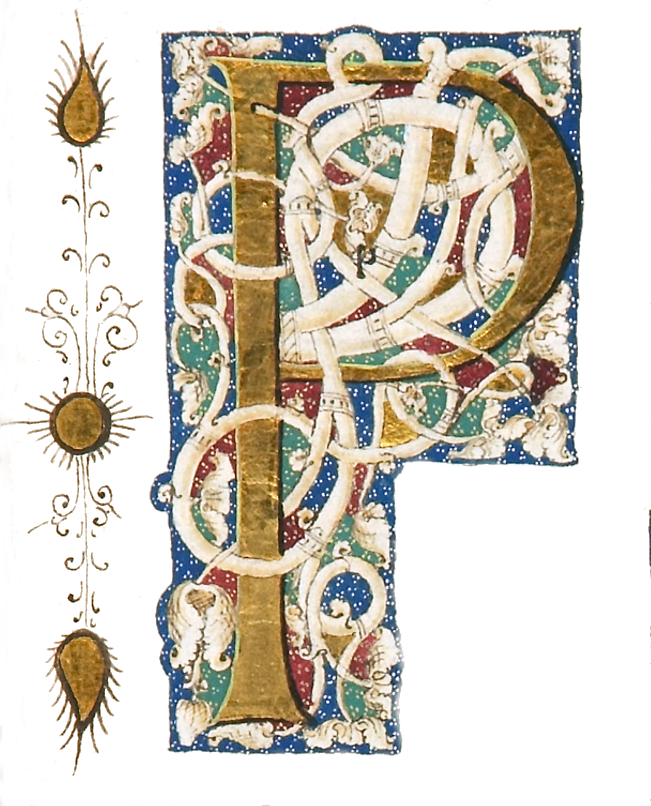post 24 Feb. 1485 · Strassburg
by (INCUNABULA). COMESTOR, PETRUS
Strassburg: [Printer of the 1483 Jordanus de Quedlinburg (Georg Husner?)], post 24 Feb. 1485. 290 x 197 mm. (11 1/2 x 7 3/4"). [232] leaves. COMPLETE. Double column, 47 lines plus headline, gothic type.
18th century sprinkled paper boards backed and cornered with blind-ruled pigskin, raised bands, ink titling to top panel, all edges dyed red. With one 12-line opening initial in red and blue, two 11-line red initials, and very many four-line and larger initials in red. Goff P-463; BMC I, 132; ISTC ip00463000. Lower cover with three-inch abrasion, a couple dozen smaller abrasions to boards, pigskin a little soiled, occasional mild browning or scattered small wormholes (affecting only margins), other very minor imperfections, but A FINE COPY INTERNALLY--especially clean, fresh, and bright, in a solid, unsophisticated binding.
Vigorously and attractively rubricated and unusually well preserved, this is an excellent copy of what scholar John Morley calls "the primary text for biblical instruction in the late Middle Ages." First printed in 1473, the "Historia Scholastica" is a biblical history covering the period from the Creation through the Acts of the Apostles, composed in the mid-12th century by theologian Peter Comestor (or Pierre le Mangeur, d. ca. 1178) while he was at the Cathedral of Notre Dame de Paris. In addition to scriptural sources, Comestor looked to classical authors and Jewish sources such as Josephus for information. It would be difficult to overstate how influential this history was: it became part of the required curriculum at Oxford and Paris, and was translated into nearly every vernacular language. Morley tells us that "as a work of literature the 'Historia' made the Bible, which can be very strange and intractable, into a coherent, orthodox, and entertaining narrative. Here we see how Comestor became the 'magister historiarum.'" Our 1485 edition was printed by the "Printer of the 1483 Jordanus de Quedlinburg," now generally considered to be Georg Husner (d. 1505), a goldsmith-turned-printer who signed only four books during his career: one in 1473, two in 1476, and one in 1498. For reasons that have never been fully understood, books--like the present one--that are easily recognized as coming from his workshop do not contain his (or any other) name in their colophons. BMC notes, "there was enough anonymous printing done at Strassburg to keep several presses busy, and if Husner only signed three books at the beginning and one at the end of his career, he may, during a long period, have been active as a printer without signing any at all." In any case, this anonymous press is distinguished especially by its types, described by Victor Scholderer as "more lively and attractive than the general run of Strasbourg faces of the 1480s." Our edition is well represented in institutional libraries, but it seems to come to market infrequently: we could trace only four copies at auction, three defective (two significantly so). Besides the present one, the only complete copy we could find was sold at Sotheby's in the Schøyen sale for $18,700 in 1991.. (Inventory #: ST20168)
18th century sprinkled paper boards backed and cornered with blind-ruled pigskin, raised bands, ink titling to top panel, all edges dyed red. With one 12-line opening initial in red and blue, two 11-line red initials, and very many four-line and larger initials in red. Goff P-463; BMC I, 132; ISTC ip00463000. Lower cover with three-inch abrasion, a couple dozen smaller abrasions to boards, pigskin a little soiled, occasional mild browning or scattered small wormholes (affecting only margins), other very minor imperfections, but A FINE COPY INTERNALLY--especially clean, fresh, and bright, in a solid, unsophisticated binding.
Vigorously and attractively rubricated and unusually well preserved, this is an excellent copy of what scholar John Morley calls "the primary text for biblical instruction in the late Middle Ages." First printed in 1473, the "Historia Scholastica" is a biblical history covering the period from the Creation through the Acts of the Apostles, composed in the mid-12th century by theologian Peter Comestor (or Pierre le Mangeur, d. ca. 1178) while he was at the Cathedral of Notre Dame de Paris. In addition to scriptural sources, Comestor looked to classical authors and Jewish sources such as Josephus for information. It would be difficult to overstate how influential this history was: it became part of the required curriculum at Oxford and Paris, and was translated into nearly every vernacular language. Morley tells us that "as a work of literature the 'Historia' made the Bible, which can be very strange and intractable, into a coherent, orthodox, and entertaining narrative. Here we see how Comestor became the 'magister historiarum.'" Our 1485 edition was printed by the "Printer of the 1483 Jordanus de Quedlinburg," now generally considered to be Georg Husner (d. 1505), a goldsmith-turned-printer who signed only four books during his career: one in 1473, two in 1476, and one in 1498. For reasons that have never been fully understood, books--like the present one--that are easily recognized as coming from his workshop do not contain his (or any other) name in their colophons. BMC notes, "there was enough anonymous printing done at Strassburg to keep several presses busy, and if Husner only signed three books at the beginning and one at the end of his career, he may, during a long period, have been active as a printer without signing any at all." In any case, this anonymous press is distinguished especially by its types, described by Victor Scholderer as "more lively and attractive than the general run of Strasbourg faces of the 1480s." Our edition is well represented in institutional libraries, but it seems to come to market infrequently: we could trace only four copies at auction, three defective (two significantly so). Besides the present one, the only complete copy we could find was sold at Sotheby's in the Schøyen sale for $18,700 in 1991.. (Inventory #: ST20168)









![BIBLIOTHECA PHILLIPPICA. [with] MUNBY, A. N. L. PHILLIPPS STUDIES](https://d3525k1ryd2155.cloudfront.net/h/228/806/1678806228.0.m.jpg)